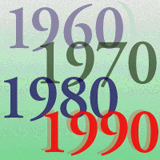 History of PRT
History of PRT
Most studies
on the feasibility of PRT date back to 1966 when a Housing and Urban
Development (HUD) study strongly endorsed this mode of transit in their
report "Tomorrow's Transportation". This report stimulated a general
effort in the early 1970's to investigate PRT and much of the mathematical
foundation for analyzing these networks was established during this time.
PRT networks for several US cities, including Los Angeles, were designed
on paper and several vehicle design concepts emerged. Within the United
States, these design concepts included Monocab, a design which utilized a
hanging suspension system, and TTI-Otis, one of the first configurations
to use air suspension and linear induction motor technology. A system
designed for West Virginia University, in Morgantown, West Virginia, was
also developed and built during the 1970's. Although highly
publicized as a PRT configuration, this system was designed to accommodate
groups of up to 21 persons rather than private parties, a principal
requirement for PRT systems as defined by the Advanced Transit Association (ATRA) in
1988.
In addition to work conducted in the United States, serious effort was
undertaken in Japan, France, and West Germany. Of these efforts,
including those in the U.S., the most thoroughly developed and tested
design was the Cabinentaxi system developed in West Germany as an urban
transit mode for the city of Hamburg. Developed during the 1970's, the
Cabinentaxi system was considered ready for implementation by 1980.
Unfortunately, a budget reduction that year forced the West German federal
government to cut back their support for municipal transit funding and
the project was shelved.
Within the past several years though, there has been a small but growing resurgence into examining PRT systems and their applicability to present-day problems. This became most evident in the United States when, in 1993, Raytheon Company bought the right
s to the TAXI 2000 PRT system concept as part of a successful effort to win a contract from the Northeastern Illinois Regional Transportation Authority to develop a demonstration system for the village of Rosemont, Ill.
TAXI 2000 was a PRT system concept originally developed at the University of Minnesota in the early 1980s and refined over the the past fifteen years by Dr. Edward Anderson, a long-time expert in the field of PRT. At the time in 1993, it represented th
e state of the art in PRT design in the U.S., although the system had never been fully tested or implemented. The current design, now being marketed as PRT 2000 by Raytheon, will be undergoing full-scale testing at a te
st track being built in 1995.
Reasons for why these systems were not further developed and implemented are difficult to assess, as no published comprehensive study on this subject has been performed. Some basic reasons though might have centered around technical problems, lack of per
ceived demand, concerns over cost-effectiveness, shifting transportation and research priorities, lack of government support, and doubts over possible adverse public reaction. In particular, some specific criticisms leveled at PRT concepts in the past ha
ve been:
- Small vehicle designs are best suited for low-density travel yet these systems require complicated, electronically-controlled guideways which would be economically feasible only on heavily travelled routes.
- A PRT system would not be able to provide the passenger carrying capacity required for adequate peak-hour performance. The one second and lower headways proposed were shorter than the required braking distances for the vehicles.
- A PRT system would require large amounts of space for guideways, stations, and vehicle storage areas. This space could better be used for improved auto infrastructure.
Developments in many different areas over the past 20 years serve to ameliorate many of these concerns and make PRT an option worth exploring further. Some of these developments include:
- Computer-based computational capabilities have drastically improved since the mid-1970's. This computational power allows for better simulation modelling ability and network design capability.
- Control theories for automated systems have matured due to the considerable investment made during the 1970's. Combined with the computational power available today, these theories can be simulated and compared using a hypothetical network.
- Advancements in LIM technology have reached a highly developed stage. This off-the-shelf technology offers a potential means of reducing headway times in a safe and reliable manner.
- Powerful microprocessors are available that are both abundant and inexpensive. These components serve to increase the on-board capabilities of the vehicles and improve the system performance, reliability, and safety.
- Automated fare collection technologies have been developed and proven in current public transit applications. Use of these technologies would serve to simplify fare collection and reduce labor cost.
These observations, combined with the growing need to improve the level of service that public transit provides, suggest that PRT be seriously studied as a realistic new mode of transportation.
Return to PRT Home Page
 History of PRT
History of PRT History of PRT
History of PRT